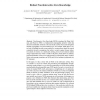60 search results - page 12 / 12 » Reaction Attacks against several Public-Key Cryptosystems |
CN
2008
13 years 5 months ago
2008
The Internet's interdomain routing protocol, BGP, supports a complex network of Autonomous Systems which is vulnerable to a number of potentially crippling attacks. Several p...
CRYPTO
2001
Springer
13 years 9 months ago
2001
Springer
Abstract. Non-Interactive Zero Knowledge (NIZK), introduced by Blum, Feldman, and Micali in 1988, is a fundamental cryptographic primitive which has attracted considerable attentio...
CCS
2005
ACM
13 years 10 months ago
2005
ACM
We describe a new encryption technique that is secure in the standard model against adaptive chosen ciphertext (CCA2) attacks. We base our method on two very efficient Identity-Ba...
CRYPTO
2011
Springer
12 years 5 months ago
2011
Springer
Strong lattice reduction is the key element for most attacks against lattice-based cryptosystems. Between the strongest but impractical HKZ reduction and the weak but fast LLL redu...
IACR
2011
12 years 4 months ago
2011
Strong lattice reduction is the key element for most attacks against lattice-based cryptosystems. Between the strongest but impractical HKZ reduction and the weak but fast LLL redu...

